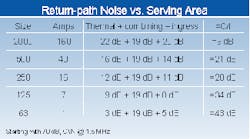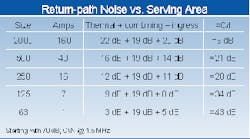Maintenance issues favor smaller HFC node sizes
The cable-television industry and others, including local-exchange carriers, municipalities, and power companies, have been deploying some form of hybrid fiber/coaxial-cable (HFC) networks since the early 1990s. The size of the node and the transport segments of the network have been determined by one of the following methods:
- determining the future network capacity demand and developing the best way to meet the future demand with today's technology
- determining the future network capacity demand and developing the least-expensive way to hedge bets
- duplicating what sounds "neat" from a published source or trade show presentation.
While all three of these methods can work, at least initially, none of them may be the entire answer. We have spent the last few years out "in the field" with the engineers and technicians who are diligently attempting to implement (and live with) their current HFC networks. Several pervasive themes have appeared almost everywhere we have worked. Outside of our experiences, you need not look very far to find evidence that we are not looking at an isolated set of problems. Proper training and test equipment, and in some cases available person-power, are a part of the solution, but network design is also a very significant factor.
The best way we have found to determine HFC network capacity is to start by determining what business you are in and the direction you want to take in the future. There is a large and expanding group of current and future services that merit consideration in this regard, including "plain old television service," commercial insertion, pay-channel subscriptions, pay per view, analog channel tiers, digital channel tiers, high-speed data, narrowcast commercials, Internet protocol voice telephony, video on demand (VOD), work-at-home service, home security services, energy monitoring and management, and wireless technologies. This evaluation process is not a trivial task, since there is no real consensus today regarding which of these services will be viable and when, what technology to use, and what subscriber penetrations to anticipate.
Once an operator has sorted out these service goals, the next step is to understand the dynamics of each of the targeted services. As an example, VOD, one of the most bandwidth-intensive services, is asymmetrical in nature. In the downstream direction, using MPEG-II compressed video, a broadcast-quality video stream uses up approximately 2.8 Mbits/sec of bandwidth. A common assumption is that after full deployment, as many as 25% of your subscribers might watch a video at the same time. These numbers suggest a need for 28 Mbits/sec of bandwidth for every 40 customers.
In a node service area that passes 500 homes and has 60% penetration, you would have 300 customers. Dividing by 40 and rounding up to the nearest whole number yields eight channels, or 48 MHz (224 Mbits/sec using 64 QAM) of RF bandwidth. In the return direction, each customer is only sending service change commands, so the bandwidth needed for the same level of usage could very well be less than 1.5 Mbits/sec. All the services offered are converted into network demands and added up to estimate the total capacity.
At this point, some operators have stopped their analysis--in our view, prematurely. Network capacity is only the first decision milestone necessary to determine the proper node size and transport technology.
The next step in rendering a network solution is to determine the technical dynamic range and allowable distortions of the plant. The first thing you discover about the dynamic range of the return path is that the return laser is the weakest link. The coaxial bus portion of the network has better than 60 dB of range from the lower side where the active devices don't have enough signal to the compression point, at which they become nonlinear. The best isolated uncooled distributed-feedback laser has about half of that. Adding a TEC cooler can help, but this solution faces two obstacles: TEC coolers do not have a -40º to +60ºC range, and they draw too much current for the application.The noise level of the return amplifiers also limits the dynamic range of the network. Since the return coaxial plant is a bus, every amplifier in the node adds thermal noise. The Table represents several different node sizes in terms of the number of homes passed. The column labeled "thermal" shows that the added noise escalates rapidly (at a rate of 10 log N in engineering terms) as the size of the node serving area increases. The column labeled "amps" represents the number of active devices in the area.
The "combining" column of the table represents typical overhead losses found in the headend or hub before the signal makes it to the device processing the signal. The "ingress" column represents typical ingress numbers that we have seen in a fairly well-maintained cable system. This particular parameter can vary widely from system to system depending on how much care and maintenance is taken in the reverse plant. Most cable operators have relatively well-maintained forward networks. They have been in this business for several decades, and their staff has experience with the equipment and plant.
The return path is another matter altogether. Not only is the subscriber equipment new and different from what the industry has been used to, but also the return plant has many quirks and the logic to troubleshoot it is somewhat new and different. All of these problems can be overcome, but it takes considerably more effort and training than many have bargained for.
The last column is "carrier to interference (C/I)," one of the most important distortion parameters. Digitally modulated RF signals have absolute lower limits in which they will operate. Quadrature phase-shift keying (QPSK), for example, will degrade rapidly below a C/I of 17 or 18 dBc.
In the scenario reflected in the Table, a QPSK signal would not be viable and would only have a 4-dB margin in the 500-homes-passed node. The bottom line is that in any analog network, the closer you are to the operating limits of the service(s) offered, the more effort you must put into maintenance.
The cable industry is approximately 40% to 50% finished with the first wave of HFC upgrades. Multiple service operators such as Time Warner have chosen to use a 500-homes-passed average node size from the start based on a fairly aggressive projection of future capacity. Other companies have taken shorter-term outlooks and let their average node size grow to upwards of 2000 homes passed.
Current network service requirements suggest that there will not be near-term problems with capacity, even at 2000 homes passed. Problems maintaining two-way HFC networks are, however, already getting bad press.
A partial solution for existing HFC operators would be to drop the node sizes as soon as possible, adding operating margin and improving the mean-time-to-repair times. New operators considering HFC architectures are especially well positioned to consider these maintenance issues in their "greenfield" network designs. The good news for optical equipment vendors is that moving to smaller node sizes means a richer mix of optical cable and optoelectronics in an HFC network.
For them and for network operators facing a dizzying array of future services (and competitors), there's more truth than ever in the maxim that a high fiber content is an important component of long-term health.Mitch Shapiro has been tracking and analyzing the growth of fiber-based networks and markets for over 10 years. He is currently a consultant with Pangrac & Associates, specializing in research and analysis focused on competitive broadband markets and technologies. He can be reached at [email protected].

